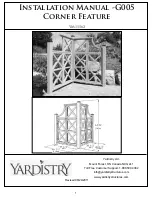
NACE GLOSSARY OF CORROSION-RELATED TERMS
©
2002, NACE International. This publication may not be reprinted without the written consent of NACE International.
Page 9 of 18
two contacting surfaces under
load which is accelerated by their
relative motion.
FURAN
Type of resin formed by the
polymerization or
polycondensation of furfuryl,
furfuryl alcohol, or other
compounds containing a furan
ring.
G
GALVANIC ANODE
A metal that provides sacrificial
protection to another metal that is
more noble when electrically
coupled in an electrolyte. This
type of anode is the electron
source in one type of cathodic
protection.
GALVANIC CORROSION
Accelerated corrosion of a metal
because of an electrical contact
with a more noble metal or
nonmetallic conductor in a
corrosive electrolyte.
GALVANIC COUPLE
A pair of dissimilar conductors,
commonly metals, in electrical
contact in an electrolyte.
GALVANIC CURRENT
The electric current between
metals or conductive nonmetals
in a galvanic couple.
GALVANIC SERIES
A list of metals and alloys
arranged according to their
corrosion potentials in a given
environment.
GALVANOSTATIC
Refers to an experimental
technique whereby an electrode
is maintained at a constant
current in an electrolyte.
GENERAL CORROSION
Corrosion that is distributed more
or less uniformly over the surface
of a material.
GRAPHITIC CORROSION
Deterioration of gray cast iron in
which the metallic constituents
are selectively leached or
converted to corrosion products,
leaving the graphite intact.
GRAPHITIZATION
The formation of graphite in iron
or steel, usually from
decomposition of iron carbide at
elevated temperatures. [Should
not be used as a term to describe
graphitic corrosion.]
GRIT
Small particles of hard material
(e.g., iron, steel, or mineral) with
irregular shapes that are
commonly used as an abrasive in
abrasive blast cleaning.
GRIT BLASTING
Abrasive blast cleaning using grit
as the abrasive.
GROUNDBED
One or more anodes installed
below the earth's surface for the
purpose of supplying cathodic
protection.
H
HALF-CELL
A pure metal in contact with a
solution of known concentration
of its own ion, at a specific
temperature, develops a potential
that is characteristic and
reproducible; when coupled with
another half-cell, an overall
potential that is the sum of both
half-cells develops.
HALF-CELL POTENTIAL
The potential in a given
electrolyte of one electrode of a
pair relative to a standard state
or a reference state. Potentials
can only be measured and
expressed as the difference
between the half-cell potentials of
a pair of electrodes.
HAND TOOL CLEANING
Removal of loose rust, loose mill
scale, and loose paint to degree
specified, by hand chipping,
scraping, sanding, and wire
brushing. [See SSPC-SP 2.]
HARDENER
[See
Curing Agent
.]
HEAT-AFFECTED ZONE
That portion of the base metal
that is not melted during brazing,
cutting, or welding, but whose
microstructure and properties are
altered by the heat of these
processes.
HEAT TREATMENT
Heating and cooling a solid metal
or alloy in such a way as to
obtain desired properties.
Heating for the sole purpose of
hot working is not considered
heat treatment.
HIGH-PRESSURE WATER
CLEANING
Water cleaning performed at
pressures from 34 to 70 MPa
(5,000 to 10,000 psig).
Содержание CP 1
Страница 1: ...CP 1 Cathodic Protection Tester Course Manual February 2005 NACE International 2000 ...
Страница 265: ......
Страница 266: ......
Страница 267: ......
Страница 268: ......
Страница 301: ...RP0169 2002 32 NACE International ISBN 1 57590 035 1 ...
Страница 535: ...TM0101 2001 24 NACE International ISBN 1 57590 137 4 ...
















































